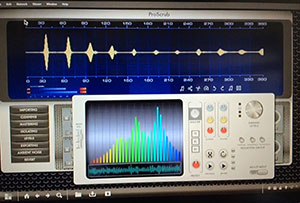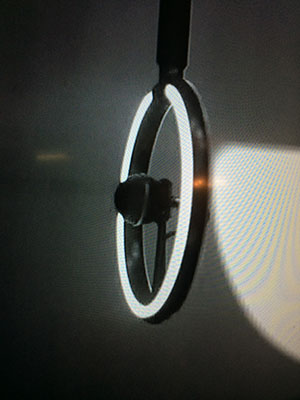 American figure skaters, Gracie Gold and Ashley Wagner, were shown in the warm-up area at the 2014 Sochi Olympics both wearing SOL REPUBLIC Tracks HD On-Ear Headphones. They had the obligatory piece of duct tape over the “SOL” logo that appear on the outside of the ear cups. But there is no disguising these headphones. Not only could you still see the solid black line extending out from under the tape, but they had the tell-tale section of head-band visible below the ear-cup. This is due to the way the SOL Republics adjustable cans slide up and down the head-band. You can even switch the headbands out for different ones. They are interchangeable!
American figure skaters, Gracie Gold and Ashley Wagner, were shown in the warm-up area at the 2014 Sochi Olympics both wearing SOL REPUBLIC Tracks HD On-Ear Headphones. They had the obligatory piece of duct tape over the “SOL” logo that appear on the outside of the ear cups. But there is no disguising these headphones. Not only could you still see the solid black line extending out from under the tape, but they had the tell-tale section of head-band visible below the ear-cup. This is due to the way the SOL Republics adjustable cans slide up and down the head-band. You can even switch the headbands out for different ones. They are interchangeable!
These headphones have a 3-button control for phone mic and music, like most modern music listening cans. They are compatible with most Apple and Android devices.
To find out more about these headphones, or to buy a pair of your own, CLICK HERE.
Archives for February 2014
Audio Analysis Software Used By Sherlock Holmes In Elementary?
 In a recent episode of the CBS show Elementary, called “Corpse de Ballet,” Sherlock Holmes used an audio software program to help solve a crime. Since I am always on the lookout for all things audio on TV, we rewound the scene and paused on a close-up of the software. It was called “ProScrub.” The problem is…it doesn’t exist. At least not that I can find.
In a recent episode of the CBS show Elementary, called “Corpse de Ballet,” Sherlock Holmes used an audio software program to help solve a crime. Since I am always on the lookout for all things audio on TV, we rewound the scene and paused on a close-up of the software. It was called “ProScrub.” The problem is…it doesn’t exist. At least not that I can find.
To the left is a picture of the software from the episode. I must have looked for hours all over the internet for audio software that looked anything like this. And my wife – “the Google Whisperer” – did the same. And if she can’t find it, then it probably isn’t out there to be found. However, there are tons of audio editing, recording, mastering, and analysis programs available. So the odds that we found them all is very low. So, if you have any knowledge of a program called ProScrub, or what real software was used if “ProScrub” is a name made up for the episode, please leave a comment below. I would very much like to know.
Sherlock used the program analyze a recording someone had made of a phone call made by the suspect. He stated that because there were two different types of ambient noise in the audio recording, it meant that it was a recording of a recording – the ambient noise from the device recording the phone call, along with the ambient noise around the person at the other end of the phone call.
That is interesting, since the name of the program is ProScrub, and what Sherlock did was not “scrubbing.” Scrubbing is not what it sounds like, which would lead most folks to think it had something to do with cleaning the audio. Not so. In the old days – before digital audio software which allows you to see (rather than just hear) the audio, if you wanted to find a very specific place in the audio, usually just before or just after a sound, you could stop the tape (yeah, that’s what we used to use to record audio:)) and slowly move it back and forth (which you could do with by literally turning the tape reels with your hands) across the player head of the tape machine. Nowadays, with the waveforms visible on a computer screen, you can just put your cursor where you need it to be and zoom in. You really don’t need scrubbing to pinpoint your location in audio anymore. But still, a lot of programs still have a “scrubbing” function.
It’s funny when a TV program tries to use terms they don’t quite understand to explain something technical. But still, the buttons down the left side of the ProScrub screen suggest some pretty useful audio functions:
- Importing
- Cleaning
- Mastering
- Isolating
- Levels
- Exporting
- Ambient Noise
- Revert
There are lots of programs that can do all of these things. typically you’d want a program that specializes in “audio editing.” Examples of such programs would include Adobe Audition and Sony Sound Forge. Of course there are dozens of others out there.
I’d still really be interested in what the real program used in Elementary was. So if you know, please leave a comment. If I find out – either from you or The Google Whisperer, I’ll update this post.
Cheers!
Ken
Bono U2 "Invisible" Mic
 For U2’s new song “Invisible,” and to support RED (the charity set up to fight AIDS), U2 launched a TV commercial during the 2014 Super Bowl. The ad shows U2 in concert performing “Invisible,” and Bono hanging onto a circular lighted microphone suspended from the ceiling/rafters. You can find out more about the album that will include “Invisible” on the @U2 site here: http://www.atu2.com/newalbum/.
For U2’s new song “Invisible,” and to support RED (the charity set up to fight AIDS), U2 launched a TV commercial during the 2014 Super Bowl. The ad shows U2 in concert performing “Invisible,” and Bono hanging onto a circular lighted microphone suspended from the ceiling/rafters. You can find out more about the album that will include “Invisible” on the @U2 site here: http://www.atu2.com/newalbum/.
Bono had the mic designed so that he could hang from it and fly out over the audience. U2 went to Tommy Voeten, President of 1212-Studio, to ask for a lighting design for their live show, and after one thing led to another, Bono asked for the circular mic (3D-printed), named the U2MIC. You can read about the design of both the mic and the other lighting and 3D printed stuff (Dimension 3D printer) here: http://www.stratasys.com/resources/case-studies/commercial-products/1212-studio.
For 24 hours after the commercial aired, you could download the song from iTunes for free. And for each download, Bank of America would donate $1.00 to support RED.
Interestingly, there is no mention on the Stratasys story (link above) about what kind of microphone was incorporated into the design. If they didn’t use an existing commercial microphone, it would at least have been helpful to know about the mic’s specs. But based on how it is being used (live lead vocals), it is almost certainly a dynamic mic (for a primer on the difference between a dynamic and condenser mic, see my post What Is the Difference Between Condenser and Dynamic Microphones?), such as a Shure SM-58, which is probably the single most widely-used stage microphone ever. In fact, in an interview with Daniel Lanois, long-time U2 Producer (though he isn’t producing this new record), he says “I’ve always recorded Bono’s vocals through a Shure SM58 or 58 Beta.” What?! That’s unheard of. Well, clearly not. But it’s nowhere near conventional wisdom to record with a Shure SM58. Conventional wisdom says to record vocals with a large diaphragm condenser microphone and sing live with a dynamic. But rules and conventions are meant to be broken. In fact, I remember reading that Tom Petty and Jeff Lynne have also been known to record vocals with the 58, so…
Anyway, I would be surprised if the actual microphone in the new U2MIC were much different (if at all different) from the Shure SM58.
I don’t know if you’ll be able to buy your own U2MIC any time soon. But you can certainly get a standard Shure SM58 or Shure BETA 58 any time. Just don’t try to hang from it over your audience;).
What The Beatles Can Teach Us About Mixing Music
This post was originally published in 2012. But given that this month is the 50th anniversary of the Beatles coming to America and playing on the Ed Sullivan Show, I thought I would revive it this February.
I’ve been a student of recording and mixing for almost 3 decades. In that time the standard “rules” for mixing music have been pretty universal. If not for the fact that I got into it a mere 15 or so years after The Beatles broke up, I would have thought these mixing rules had been around forever. Certain things like panning the kick drum, bass guitar and lead vocal to the dead center of the mix (in other words, not panning them at all), and balancing the stereo field with guitars, pianos, harmonies and other instruments placed across the sound stage so we hear them spread out left-to-right, were things that “everybody knows.” But they’ve only known them since about 1970 or so.
But I’ve been listening to a lot of Beatles music in the past few weeks. Thank you iTunes and Apple Records (no relation) for finally coming to a sane agreement to make their music available for download! When I was a kid I didn’t notice that things were a bit wonky on the records I had. Maybe I had original recordings where they were in mono (nothing panned left or right), I really don’t know. And since my brother took all my records decades ago, I can’t check – not that I am bitter.
But in listening to The Beatles these past few weeks I became acutely aware of how hard it was to listen to at times. I mainly listened while driving in the car (…”yes I’m gonna be a star” – sorry), so when songs had all the drums panned to the left channel and a lead vocal coming from the right channel all the way over in the passenger side door, I couldn’t fully enjoy the music because part of my brain was trying to hear the lead vocal and another part was freaking out about how “wrong” the mix was.
I thought I had remembered that the whole concept of stereo was new in the 1960s, at least for use in pop records, and that The Beatles were early pioneers and tried all manner of wacky mixing. But it turns out only part of that was true – the part about stereo being new. George Martin and crew produced everything (at least before the days of The White Album and Abbey Road ca 1968/1969) for mono, and that is the way they sound the best. The early recordings, up until 1964, were recorded on “twin-track” tape. So the instruments all went on one track, and the vocals went on the other. That makes sense if two tracks is all you have. It lets you mix it so that the vocals and instruments blend and balance properly. Those songs were optimized for mono and how they were meant to be heard. It wasn’t until 1966 or so that George Martin and crew decided to remix a bunch of songs for stereo, without the involvement of The Beatles themselves.
So when the early recordings prior to Rubber Soul were changed for stereo, the only choice they had was to put instruments on the left channel and voices on the right, leaving a kind of sonic hole in the middle. This sounds really odd to our post-1960s ears. But even when they started recording on 4-tracks start with Rubber Soul, they didn’t change the instruments-to-the-left and voices-to-the-right tactic except for a few exceptions where a guitar might show up in the right channel, or a harmony might be panned to the left.
Almost nobody in The Beatles’ primary listening audience (teenagers) at the time owned stereo record players. They were all listening on what they called “monaural” or “monophonic” players. So when George Martin was experimenting with stereo mixes, he wasn’t too worried about ruining anything because he knew very few people would ever actually hear the stereo versions. But as is often the case with technology, stereos became common around 1970, so those “stereo” versions were out in the world for better or worse. In the 1980s, George Martin did some much needed remixing to improve the stereo mixes, and they are better now. Things are spread more evenly across the stereo sound-stage. But he still only had 4 tracks to work with, so not every instrument or voice is on its own track. The drums, for example, are still all mixed to the left because they were all on a single track.
All this got me thinking about how quickly things become standard and rules become universal and in some cases, inviolate. But there were no stereo mixing rules just a few decades ago. The things we consider to be “correct” are not age-old wisdom as I was treating them. On the one hand it’s a good thing. It makes it easy to teach people how do do things. On the other hand, it can stifle creativity. What seems right and proper in the audio recording industry today may turn out to be “wrong” 20 years from now.
The Beatles changed a lot of those rules in the 60s in other areas, like recording backwards music, doubling lead vocals and guitar leads, applying more treble than the engineer said was correct on Nowhere Man, and the list goes on. So while we are recording, let’s remember that rules are often made to be broken in the name of creativity. Who knows? You may end up writing the new rules.
